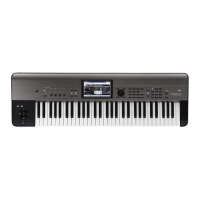Program mode
64
Program: Menu Command
ENTER + 0–9: shortcuts for menu com-
mands
Each page has a set of menu commands, which provide
access to different utilities, commands, and options,
depending on the page you’re currently on. You can use the
menu commands entirely from the touch‐screen, by
pressing the menu button in the upper right‐hand corner of
the screen and then selecting an option from the menu that
appears.
Even though each page may have its own unique menu
commands, the menus are standardized as much as
possible. For instance, WRITE is almost always the first
menu item in Program, Combination, and Sequencer modes.
You can take advantage of this standardization by using a
shortcut to access any of the first ten menu items:
1. Hold down the ENTER button.
2. Press a number (0–9) on the numeric keypad to select
the desired menu command, starting with 0.
For instance, press 0 for the first menu command, 1 for the
second, and so on.
If the menu command just toggles an option on and off
(such as Exclusive Solo), then you’re done. If the command
calls up a dialog box, the dialog will appear on the display,
and you can proceed just as if you’d selected the command
from the touch‐screen.
Tip: While this command is open, the ENTER button will
operate as the OK button and the EXIT button will operate
as the Cancel button.
Procedure for menu commands
1. Select the menu command.
2. Make settings in the dialog box.
For details on the content of each dialog box, refer to the
explanation of each command.
3. To execute, press the OK button. To cancel without exe-
cuting, press the Cancel button.
Write Program
This command writes an edited Program into the KROME
internal memory. It is available on every page in Program
mode.
Write Program lets you:
• Save your edits
• Rename the Program
• Assign the Program to a Category
• Copy the Program to a different Bank and number
Be sure to Write any Program that you wish to keep. An
edited Program cannot be recovered if you do not write
it before turning off the power or selecting another
Program.
Note: You can also access and execute this command by
pressing the WRITE button.
1. The upper line of the dialog shows the Bank, number,
and Program name.
If you wish to modify the program name, press the text edit
button to move to the text edit dialog box, and enter the
desired program name.
2. In Category and Sub Category, specify the category of
the program that you are writing.
The category can be used to find this Program when
selecting a program in Program, Combination, or Sequencer
modes.
Note: You can edit these category names in the Global P4:
Category page. For more information, please see “4–1:
Program Main” and “4–2: Program Sub” on page 204.
3. Press “To Program” to specify the destination Bank and
number.
You can also use the BANK A–F buttons to select a bank.
You cannot save to banks G–g(d). If you've edited a program
from banks G–g(d) and want to save it, save the edited
program to a bank A–F.
Exclusive Solo
The behavior of the Solo function will alternate each time
you select Exclusive Solo.
The Solo function can operate in one of the following two
ways.
• Multiple Solo
The specified OSC1, OSC2, or drum track will be soloed. The
solo on/off setting will alternate each time you press the Solo
button.
•Exclusive Solo
Only one source ‐ OSC1, OSC2, or the drum track ‐ will be
soloed.
Note: Solo operations can be performed in the P0–3: Mixer &
Drum Track page of each mode.
Note: The Solo function applies to each mode. All sources
are handled as a single group. In the case of Exclusive Solo,
all other sources will be off if even one source is being
soloed.
1. Use the menu to select Exclusive Solo.
When you select this item, a check mark will be added at the
left of Exclusive Solo in the menu. The check mark will
appear or disappear each time you select this item.
No check mark: Multiple Solo
Check mark: Exclusive Solo
Alternatively, you can turn this setting on/off by holding
down the ENTER button and pressing numeric key 1.

